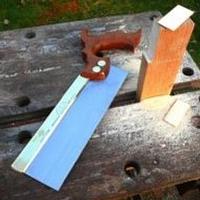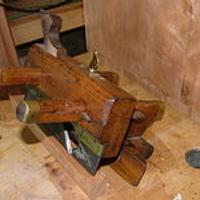Share your craft projects
Make new craft buddies
Ask craft questions
Blog your craft journey

Brit
453 posts
and
39 followers
in over 11 years
in over 11 years
More from Brit
YouTube makes me laugh
Beginner's Guide to Sharpening Western Saws
The Humble Hand Brace - A Beginner's Guide to Restoring, Buying and Using #8: Part 8 - Tips and Tricks on Using a Hand Brace
The Humble Hand Brace - A Beginner's Guide to Restoring, Buying and Using #7: Part 7 - Sharpening an Auger Bit
The Humble Hand Brace - A Beginner's Guide to Restoring, Buying and Using #6: Part 6 - What to Look for when Buying a Secondhand Brace and more
Carving a Welsh Love Spoon #2: The Caged Ball
This is
part 2
in a
5 part
series:
Carving a Welsh Love Spoon
In this episode, I show you how I tackled the caged ball section of the Welsh Love Spoon. I started by squaring the outside of the cage and transferring the aperture opening to the other three sides. I then marked the diameter of the ball on the other three sides, but whilst doing that I found myself wondering whether or not the ball I'd drawn was the right diameter. After all I just drew a ball freehand along with the rest of the spoon. Should it be a certain diameter and if so, how big?

I reasoned that the ball needed to move up and down freely in the cage, but that there shouldn't be a lot of side to side play. So I measured the width of one of the apertures (A) and drew a quick sectional view of the cage (as if I'd sawn through it and was looking down on it). It was then obvious that the diameter was the distance between the internal corners of two diagonally opposite posts (B). Needless to say the ball I had originally drawn was too small. As luck would have it though, a 50 cent coin (Euros) from my holiday change jar was exactly the right size.

Having reassured myself that the ball was now the right diameter, I got to wondering how I'd know when I was at the right diameter once I started to chip away at the surrounding wood. So I decided to make a couple of crude templates out of an old hotel card key. The depth gauge 'D' will let me know when I'm at the right depth from each face and the arc 'C' will help me keep the ball spherical.

I decided to excavate the waste either side of the ball first and leave the ball intact for the time being. This would give me more space to maneuver my knife to shape the ball. First I made two stop cuts to sever the end grain, followed by two along the grain on each face to define each aperture.

Then I cut a knife wall so I had a shoulder to slice into without cutting into any wood that should remain.

I kept deepening the stop cut as I removed more and more chips. Once the inside walls of each corner post were as deep as the width of the posts on the surface, I stopped. Notice that at the moment I am effectively treating the ball as a cylinder when viewed from any of the faces.

Repeat for the other three sides.

I was then able to get more movement on my knife and use my thumb as a fulcrum to slice through the end grain until the center piece popped out.

Finally I could see daylight. Yippee!!!

I then repeated the whole procedure for the other end.

I must give a 'shout out' to the Mora 106 woodcarving knife. When I was in the market for a good carving knife, I looked at comparable knives made by Hans Karlsson (£53), Svante Djarv (£43) and Ben Orford (£60). All good knives I'm sure. However, I read an article by Robin Wood where he extolled the virtues of the Mora 106 (£16.95). Robin makes his living from green woodworking and knows a thing or two about knives. I respect his opinion, so I thought I'd give it a try and I'm glad I did. It takes and holds a great edge, is comfortable to hold and will tackle anything from aggressive slicing cuts to paring end grain or adding fine details. Let's face it, there aren't many cheap tools these days that surprise you with their performance, but this one puts a smile on my face each time I pick it up.

I'm afraid I forgot to take any photos of my progress as I carved the ball. Basically though, I just kept chipping away at it from each side and testing my progress with my templates until the ball became separated from the cage. I have to confess that I found this harder than I thought it would be, although I'm sure I could do a better job next time. The reason I found it hard is that although I was trying to carve a perfect sphere, I couldn't actually see the whole sphere through any of the windows, so it was difficult to see where wood needed to be removed. Consequently, once the ball finally became separated from the cage, it was more like the shape below.

The other issue I found was that once the ball was no longer joined to the cage, it was difficult to hold on to it while I further refined the shape. Still, better to take off too little than too much eh? I basically just kept sneaking up on a perfect sphere until I could rotate the ball in any direction without it binding. I still have a little bit of refining left to do before I'll be happy with it. I'm so glad I decided not to carve three balls in the cage! Anyhow here is where I'm leaving it for now. I've included two photos showing the ball in different positions to prove it does actually move.


Next I'll tackle the bowl of the spoon.
Thanks for watching!
Thanks for watching!
Andy -- Old Chinese proverb say: If you think something can't be done, don't interrupt man who is doing it.
2 Comments
Cool project, and a good quite time woodworking.
Main Street to the Mountains
I was wondering how you were going to keep the ball spherical, the templates are a great idea. Estimating the ball's accuracy by eye would be tough.
Keep up the good work.
Keep up the good work.
More from Brit
YouTube makes me laugh
Beginner's Guide to Sharpening Western Saws
The Humble Hand Brace - A Beginner's Guide to Restoring, Buying and Using #8: Part 8 - Tips and Tricks on Using a Hand Brace
The Humble Hand Brace - A Beginner's Guide to Restoring, Buying and Using #7: Part 7 - Sharpening an Auger Bit
The Humble Hand Brace - A Beginner's Guide to Restoring, Buying and Using #6: Part 6 - What to Look for when Buying a Secondhand Brace and more










